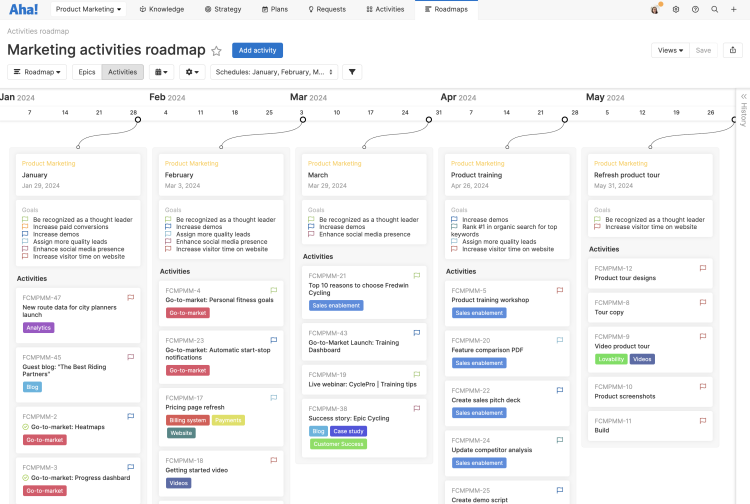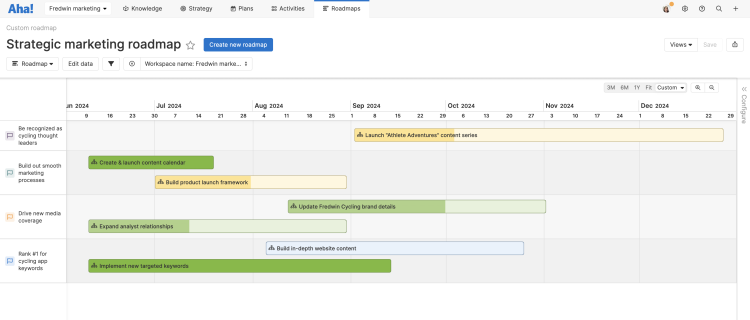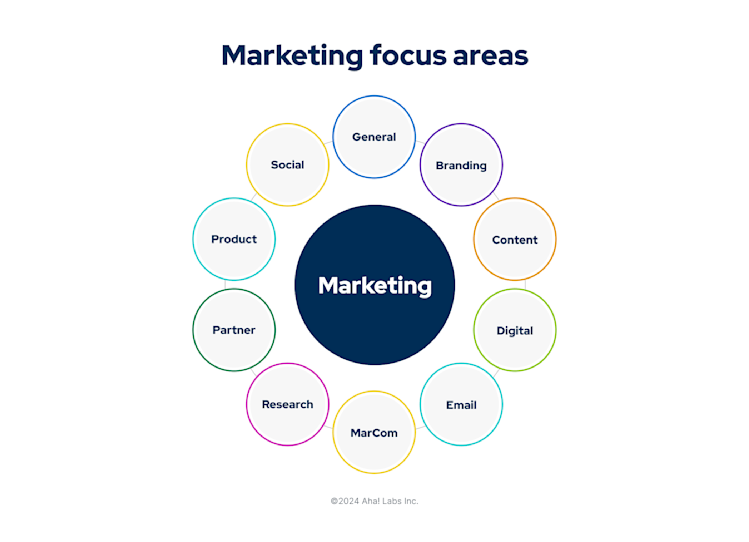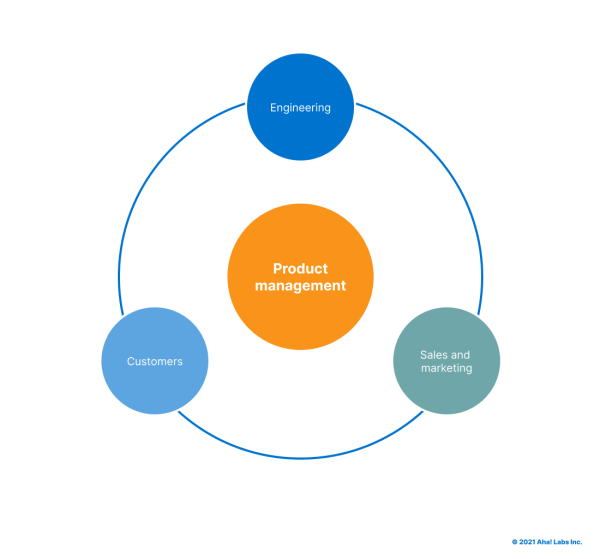How to market your product
A guide to the basics you should know as a product manager
Last updated: April 2025
Marketing fuels growth. It is a driver of any successful business — boosting everything from brand recognition to customer loyalty, and especially product adoption. When you launch a feature or reposition your offering, marketing is how you get the word out about all that is new and improved.
This is how marketing connects to your work as a product manager. So it is worthwhile to understand what goes into promoting the product you build. That way, you can be a better partner to your marketing team and help them tell the product story in a way that supports your overall vision.
In this guide, learn the basics of marketing plans and how product managers can contribute (with some visual examples, too). Skip ahead to any section:
Why is it important to have a marketing plan for your product?
How will you promote your product after its release? How will you make sure to reach the right customers and stand out in the market? The answers to these questions typically live in a marketing plan.
The marketing team will be responsible for creating this plan and understanding which approaches are most effective for your market and customers. But as a product manager, it is helpful to be familiar with what goes into this process. This ensures you can provide the most relevant insights.
A marketing plan provides an essential outline of the work to be done to showcase your product offering and attract new customers. It should support the marketing strategy as well as overall company objectives — so it is clear how any marketing activities will drive progress on broader goals. A solid plan also helps to establish the timeline and themes for upcoming work, so everyone on the marketing team can stay in sync and on schedule.
Other benefits of having a marketing plan include:
Alignment between different marketing groups and cross-functional teams
Focus on prioritized marketing activities and requests
Coordination of key milestones and deliverables
Visibility into the direction and progress of marketing work, especially for leadership
Accountability by tracking performance targets as part of the plan

A visual marketing plan example with goals and planned activities created in Aha! Roadmaps
What should your marketing plan include?
A marketing plan is not so different from a product release plan — it includes key activities and timelines for delivering something new to customers. But instead of product functionality, the outcome of a marketing plan is usually a new campaign or initiative designed to drive awareness, engagement, or demand.
Marketing plan details often vary by industry, company size and budget, product type, and target customers. (Your marketing teammates will be the experts on what works well for your business.) But in general, a full marketing plan should include:
Marketing goals: Measurable, time-bound objectives to help track success (e.g., increase product trials 20% by the end of the quarter)
Research analysis: Background information on market and customer trends that support the plan
Target audience: Definition of who you plan to reach with the marketing plan and why
Positioning and messaging: Clear value proposition and key differentiators to communicate
Timeline: Start and end dates for the plan, including important milestones along the way
Dependencies: Marketing activities that require support from other teams
Channels: Details on how the plan will be implemented across various marketing channels (e.g., advertising, email, website)
Key deliverables: Content and creative assets to develop for promotion
Sales and support enablement: Collateral, training, and resources to help with promotion
Budget and resources: Breakdown of planned spending and required capacity throughout the plan
Reporting: Metrics and views that can help monitor progress and impact

A marketing plan example mapped out on a roadmap timeline. This custom view was created in Aha! Roadmaps.
It is worth noting that the components listed above represent everything that typically goes into a marketing plan to support a new product launch or major area of functionality. You will likely not need a full marketing plan to promote every new product feature or enhancement.
Types of marketing plans
Most marketing teams are comprised of multiple functional groups, such as content, digital, social media, and product marketing. Each of these groups is responsible for the different channels and deliverables within their focus area.

In many cases, each marketing group will create its own plan that rolls up to the broader marketing one — including extra details and more specific tasks. You might even have plans dedicated to specific channels, like email. It all depends on the marketing team's size, budget, and understanding of which strategies are effective for your audience.
Here is a brief overview of some of the most common types of marketing plans you will see:
Type of marketing plan | What it does | What it includes |
Content marketing plan | Captures how you will reinforce key messages and provide value to your audience by publishing content that educates, inspires, or helps them solve a problem |
|
Digital marketing plan | Lays out online channels plus paid and organic tactics that you will use to reach and engage your target audience |
|
Product marketing plan (or go-to-market plan) | Shows how you will bring a new product or customer experience to market and communicate the benefits |
|
Social media marketing plan | Identifies how you will interact with your target audience on social platforms, including a mix of paid advertising and follower engagement |
|

An example of a marketing calendar pulling in content, digital, and go-to-market plans. Create your own calendar view with Aha! Roadmaps.
What does a product manager do in terms of marketing?
We mentioned that product managers help inform marketing plans, even if you are not directly responsible for creating them. So, let's go over what that looks like in practice.
Marketing can support many different business areas — from branding to hiring efforts and sales enablement. But the primary goal is often to grow company and product awareness. To achieve this, marketing teams work to understand customer needs and highlight how your solution meets them. Product marketing groups especially focus on communicating your product's unique value to the target audience.
This is where product management comes in. As experts on your product and customers, product managers are a valuable source of information for marketing teams. This means they contribute insights to marketing plans both directly and indirectly. For example:
Product managers often collaborate directly with product marketing on product positioning, customer personas, and go-to-market plans.
Product managers indirectly inform other marketing efforts by sharing takeaways from market research, customer conversations, and product usage.
Outside of launch plans, you likely will not be involved directly in many marketing decisions. But there are still meaningful ways to contribute. After all, both product management and marketing share similar goals: delivering the right solution to the right people, whether by building the product itself or communicating its benefits.
If you are curious to learn more about the relationship between product management and product marketing, check out the resources linked below.
Related:
5 tips on how product managers can help market your product
So, should product managers help with website copy or creative campaign ideas? Probably not. But the more you can convey the true value of what you are building to your marketing team, the better they will be able to pass that message on to customers in a way that resonates.
The best way to do this is by openly sharing your knowledge and collaborating with marketing on bigger directional efforts. You likely have more opportunities to do this than you realize. Here are a few tips to get started:
Share product insights. Marketers explore customer and competitor research, too. But few have the same access to users as you do. Find ways to regularly share what you learn — especially from customer feedback. You can do this in person or via internal product documentation that marketing (and other teams) can self-serve.
Collaborate on positioning, personas, and messaging. These strategic elements are where product management and marketing (specifically product marketing) overlap the most. Work together to define who you will serve (both buyers and users) and what you want them to know about your product.
Reveal your plans. It takes time and effort to develop marketing assets for product promotion. So, let your marketing team know what is coming next by clueing them into your product roadmap. When they are better informed about your plans, you can expect a smoother and faster introduction to the market.
Support content creation and events. Authority matters in marketing. Lend your subject matter expertise to help the marketing team craft well-informed content. Or offer to participate in live panels, webinars, and other events your marketing team puts together. Think of these as bonus opportunities to connect with customers, too.
Talk live. If you find that you are not naturally interacting with many marketing team members in your day to day, consider setting up occasional time to meet and discuss how to support one another. This is also a good way to make sure shared assets like positioning and personas stay fresh. Try a whiteboard session to let the ideas flow — these templates can give you a boost:
FAQs about product management and marketing
Product managers do not need to be marketing experts. But you should understand how your product's value is communicated across the customer journey, including the messaging and channels used. This basic knowledge will help you provide more helpful insights to your marketing team and learn more about who your customers are in turn.
It is important to coordinate with marketing from the start of the product development process. You will want to develop messaging and positioning alongside the product — not after it is built. Early alignment between product management and marketing can lead to more impactful launches.
In brief, product management is about defining what to build and why. Product marketing considers how to communicate the benefits of what you build. Both teams work together to understand customer needs and coordinate go-to-market launches.


